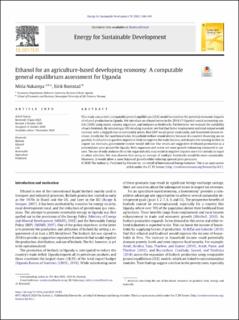| dc.contributor.author | Nakamya, Miria Kil Ji Jong | |
| dc.contributor.author | Romstad, Eirik | |
| dc.date.accessioned | 2021-03-23T13:18:09Z | |
| dc.date.available | 2021-03-23T13:18:09Z | |
| dc.date.created | 2020-11-18T09:28:04Z | |
| dc.date.issued | 2020 | |
| dc.identifier.citation | Energy for Sustainable Development. 2020, 59, 160-169. | en_US |
| dc.identifier.issn | 0973-0826 | |
| dc.identifier.uri | https://hdl.handle.net/11250/2735131 | |
| dc.description.abstract | This study uses a static computable general equilibrium (CGE) model to examine the potential economic impacts of ethanol production in Uganda. We introduce an ethanol sector in the 2016/17 Uganda's social accounting matrix (SAM) using maize, cassava, sugarcane, and molasses as feedstocks. Furthermore, we evaluate the suitability of each feedstock. By simulating a 10% blending mandate, we find that factor employment and total output would increase, with a sluggish rise in commodity prices. Real GDP would grow moderately, and household income increase, mostly for the rural households. Household welfare would decline because of a counter-financing tax on gasoline. A reduction in gasoline imports is likely to improve the trade balance, and despite the ensuing decline in import tax revenues, government income would still rise. Our results are suggestive of ethanol production as a potential pro-poor project for Uganda. Both sugarcane and maize are more growth-enhancing compared to cassava. The use of only molasses from the sugar industry may result in negative impacts since it is already an input in other activities. We also observe that using an average of multiple feedstocks would be more sustainable. Moreover, it would allow a more balanced growth while reducing upward price pressures. | en_US |
| dc.language.iso | eng | en_US |
| dc.relation.uri | https://www.sciencedirect.com/science/article/pii/S0973082620303124 | |
| dc.rights | Attribution-NonCommercial-NoDerivatives 4.0 Internasjonal | * |
| dc.rights.uri | http://creativecommons.org/licenses/by-nc-nd/4.0/deed.no | * |
| dc.title | Ethanol for an agriculture-based developing economy: A computable general equilibrium assessment for Uganda | en_US |
| dc.type | Peer reviewed | en_US |
| dc.type | Journal article | en_US |
| dc.description.version | publishedVersion | en_US |
| dc.source.pagenumber | 160-169 | en_US |
| dc.source.volume | 59 | en_US |
| dc.source.journal | Energy for Sustainable Development | en_US |
| dc.identifier.doi | 10.1016/j.esd.2020.10.003 | |
| dc.identifier.cristin | 1849053 | |
| cristin.ispublished | true | |
| cristin.fulltext | original | |
| cristin.qualitycode | 1 | |

